PHOTO
Many emerging market (EM) managers are increasing their allocations to Middle East and North Africa (MENA) markets, especially to Saudi Arabia, a fund selector from Swiss private bank Union Bancaire Privée (UBP) has told Zawya.
“People are more and more looking at frontier markets and how the indices are gradually incorporating those frontier markets, so we have been increasing research on MENA in the last few years, just to make sure we understand who the players are,” Cédric Le Berre, fund selector and portfolio manager at UBP said in an interview last week, noting that MENA remains a niche region for the bank’s clients.
Within the region, however, he said: “We favour Saudi Arabia, and this is where we see EM managers focusing and allocating money, partly because of the MSCI upgrade but also because the market is very liquid and very large in size, so people feel comfortable with that.”
The awaited inclusion of the Saudi market in the FTSE Russell emerging market index later this month, and in the MSCI and S&P Dow Jones indices from June and July respectively, is expected to attract billions of dollars from foreign funds to the market - both passive and active funds.
“Saudi Arabia continues to be a very important element of the MENA equation, North Africa has lost a little bit of importance, people are very much looking at the United Arab Emirates (UAE) and Saudi Arabia,” Le Berre added.
He said that people are mainly looking at the “dynamic in terms of real estate, financials and consumption as the key three leading sectors in this region but also some of the technology hubs that are being built in the Middle East.”
On UAE markets, Le Berre said that he sees good dynamics for the time being, thanks firstly to stabilising oil prices. “Secondly, we see the financial crisis as (having) cleaned a little bit from the most exuberant sectors. Thirdly, we see a lot of political stability, which is very positive,” Le Berre said.
Brent oil prices dropped 19 percent during 2018, data from Eikon showed, but have risen by more than 23 percent since the start of this year, recovering all of the losses incurred last year.
Dollar respite
Le Berre highlighted three factors which he said were supportive of growth in emerging markets.
The first is that appreciation in the value of the U.S dollar has “paused, providing EM markets a relief, and that should keep up throughout 2019.”
The dollar index, which measures the greenback against a basket of six major currencies, has gained in value by 1.2 percent since the start of 2019, compared to a 4.68 percent increase in 2018.
The second opportunity, according to Le Berre, is that “commodity prices have stabilised, which is very good for Brazil and Russia, and also for the Middle East”.
The third is that “trade tensions between the U.S. and China are seeing some relaxation and that is very good for Chinese equities, but also for Asia overall,” Le Berre said
“That is the reason why today we like very much Asia, with China as our favourite market, but also with some regard we like the commodity-driven markets like Russia, Brazil and the Middle East,” he added.
More generally, given the volatility in the market in late 2018, Le Berre said that active management of stocks in many markets could be difficult in 2019, adding that taking a passive approach to U.S. equities may prove to be a better strategy.
For emerging markets, Le Berre said that if the recent rally continues, passive management might also be better for commodity-driven countries, such as Russia, Brazil and Middle Eastern countries.
In the first two months of 2019, the MSCI emerging market index has gained 8.83 percent, data from Eikon shows.
“Apart from that, you need to be active. In Europe, you need to be active because you have a lot of opportunities and we see that the investment community is doing well,” Le Berre said. He added that picking stocks, rather than indices, was also important for investing in China and wider Asian markets.
Active approach to bonds
For fixed income markets, Le Berre said that it is important to be active “because the benchmarks are not yielding very much, so if you really want to create value for your clients, you need to be very directional in the fixed income space, have a strong view on the U.S. economy, on the interest rates cycle, and also on the fact that in Europe, the periphery should continue to do better”.
On the bank’s allocation strategy, Le Berre said that it is slightly overweight on equities as “the pessimism that took place at the end of 2018 was overdue and we think that valuations especially in Europe, Japan and Emerging markets (EM) are still very attractive, so we are overweight EM, Japan in our portfolios.”
Data from Eikon shows that the MSCI’s world stocks index has dropped 10.44 percent in 2018, after retreating in the last quarter of the year by 13.91 percent, as trade tensions between the United States and China weighed on investor sentiment in the last couple of months of the year.
In the fixed income space Le Berre said that UBP is “gradually reentering emerging debt”.
“We were out of (emerging debt) last year but back in this year. We continue to like high-yield as well, despite the fact it is an overcrowded trade. There is still a very strong potential and people are still looking for yields.”
UBP is a Swiss private bank that was founded in 1969, focusing on wealth management for private and institutional clients. The bank managed 126.8 billion Swiss Francs ($125.8 billion) in assets as of the end of 2018 and has had a presence in Dubai International Financial Centre since 2011.
(Reporting by Gerard Aoun; Editing by Michael Fahy)
(gerard.aoun@refinitiv.com)
Our Standards: The Thomson Reuters Trust Principles
Disclaimer: This article is provided for informational purposes only. The content does not provide tax, legal or investment advice or opinion regarding the suitability, value or profitability of any particular security, portfolio or investment strategy. Read our full disclaimer policy here.
© Reuters News 2019












